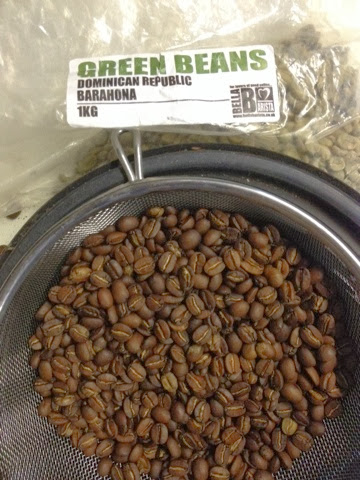Host Fiera Milano 2013 has just been held, which means exciting product announcements from the global coffee manufacturing companies. Coffee Channel will therefore list some of the more spectacular announcements below, but first off, lets starts clarifying what the Host event is?
Host is the biggest hospitality industry expo in the world and takes place every other year, where thousands of vendors from different industries (Ex., Furniture and home wears, food service equipment, tea and coffee) collides under the same roof.
1. Victoria Arduino 388 Black Eagle, Espresso Machine
Victoria Arduino - owned by Nuova Simonelli - is the espresso machine manufacture that produces the most aesthetic and delicate machines, and the release of the new concept prototype of the 388 Black Eagle is only a statement of that. This newly announced espresso machine is essentially a re-design of the great Nuova Simonellis Aurelia T3 machine, where the aesthetics is taken to a whole new level.
James Hoffmann (2007 World Barista Champion), have in cooperation with Nuova Simonelli designed the 388 Black Eagle and the most exiting feature is the machines built-in gravimetric weighing system, which is incorporated directly into the grate above the machines drip tray.
"The gravimetric capabilities of the Black Eagle are designed around individual load cells, stored inside the machine and mounted within the drip tray grates using a simple and easy to remove latch. These load cells weigh the volume in a cup, which is the displayed in a digital read out above the group head, featuring both time and weight data. Software inside the machine tells the load cell what to read and what to ignore for example, the software can distinguish between reading shot volume and a barista´s hand inadvertently bumping the drip tray. Smart software is the key to making this gravimetric system work as advertised." Quote from sprudge.com
The new 388 Black Eagle is therefore a result of James Hoffmanns opinion that beverage mass is the most important factor in extraction and the beverage mass is king - we´re not as obsessed with brew time as we once were.
2. Sanremo Opera, Espresso Machine
The Opera espresso machine is made by the Italian company, Sanremo, based in Treviso. They have together with John Gordan (UK Barista Champion), developed an impressive new beast of an espresso machine.
The monstrous machine has impressive five individual insulated boilers, one for each of the three group heads, one steam boiler and another boiler, the pre-heates the circulating water over the top of each group. The spectacular about this machine, is that is holds the option of two different flow rates!
3. Nuova Simonelli Clima-Pro, Grinder
James Hoffmann, Colin Harmon, Fritz Storm and Gwilym Davies have together worked on the Clima-Pro project, where they have tested and tweaked for two years. The main concern was that the majority of espresso related problems can be traced back to the grinder (Everything like, speed of service in the cafe, effectiveness of that service, morale of your staff, roast profiling, how we explore coffee and learn about coffee - it all comes back to grinding says Colin Harmon). The group noted that their had been some remarkable changes on the espresso machine side lately, but unfortunately not on the grinder side.
The group was therefore determined to locate the main factor to improve and found it - ideal temperature for grinding espresso. Along with researchers from University of Alcona, the determined the best grinding range was between 35 and 45 degrees Celsius. The Clima-Pro grinder from Nuova Simonelli is therefore able to keep the temperature at 35 degrees for about 10 minutes, at intensive grinding.
4. Marco JET, Coffee Brewer
The newly announced coffee brewer is from Marco Beverage Systems, and is a new batch brewer. The JET model is a filter coffee brewer, with a vacuum insulated dispenser and a touch-screen interface, and can brew between 2,0-6,0 l. of coffee per brew. The JET is designed to match the SCAE Gold Cup brewing standards, and is able to deliver less than 1% variance in water volume delivery and +/- 1,5 degrees temperature delivery (at the spray head). The announced JET brewer is currently a prototype, says David Walsh from Marco Beverage System, but the coffee firm is edging closer to locking in the final design. The Jet will therefore hit the coffee market in the early 2014.
5. Mazzer "Kold", Grinder
The Italian grinder manufacture, Mazzer, has announced their new grinder, which is called the Kold. This grinder uses the same burr-set as the notorious Mazzer Robur, but the burrs is mounted offset on a belt-drive system, so that the heat from the motor doesn´t affect the coffee or burrs - thereby are Mazzer now mainly focusing on keeping the temperature of the burr-set and coffee grounds low.
You have properly already noticed that the well known Mazzer collar system in the above picture is gone and therefore re-designed, so you know are able to adjust the grind setting at the side-mounted dial. Mazzer have also received a lot of criticism, cause their previous collar system wasn't easy to adjust, so hopefully the new side-mounted adjustment dial is way better.
6. Marco Single Cup Brewer, Splurty
Marco Beverage System which also announced the JET coffee brewer, has also presented the Splurty. The Splurty is a minimalistic designed one cup brewer, that demands a minimum of counter-top space. The coffee brewer uses the Marco Pillar technology and is designed for Kalita filter baskets, - but is not limited to this particular brewing device - which is being held in place on the machines back panel using a magnetized basket holder.
The brewing device functions like many other, where the heated water is dispensed over the top of the basket, where coffee volume and timing standards is selected by the user.
All pictures are from sprudge.com
// Hendrup



























.JPG)













.JPG)

.JPG)






